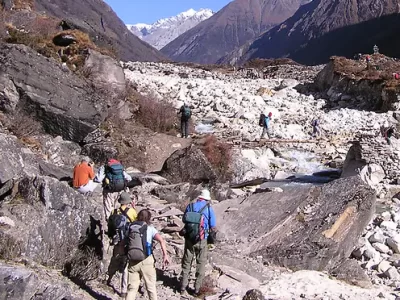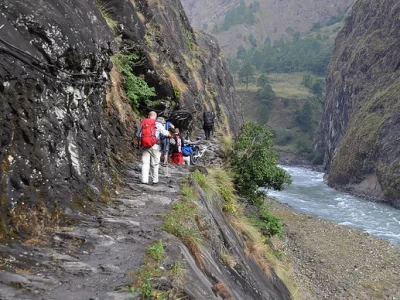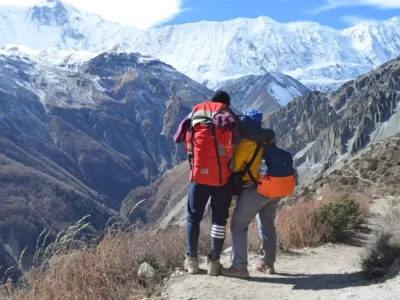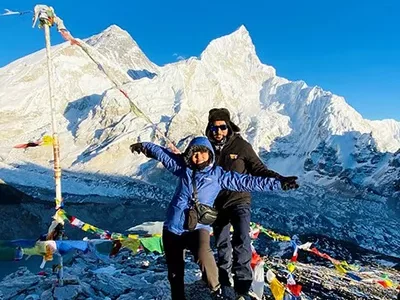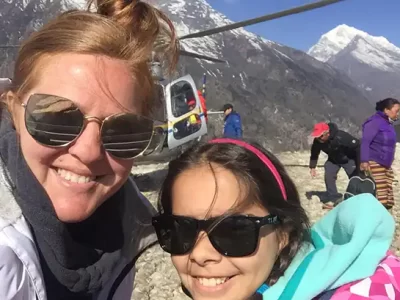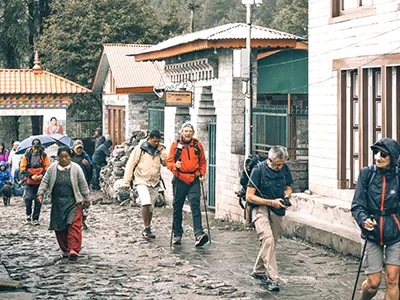The Manaslu Circuit Trek offers a spectacular adventure that unveils the untouched beauty of the Himalayas. Circling Mount Manaslu, the world’s eighth-highest peak, this trek blends breathtaking natural landscapes with rich cultural encounters. Its paths are less trodden compared to Nepal’s more frequented routes, offering tranquility and a true escape for adventurers.
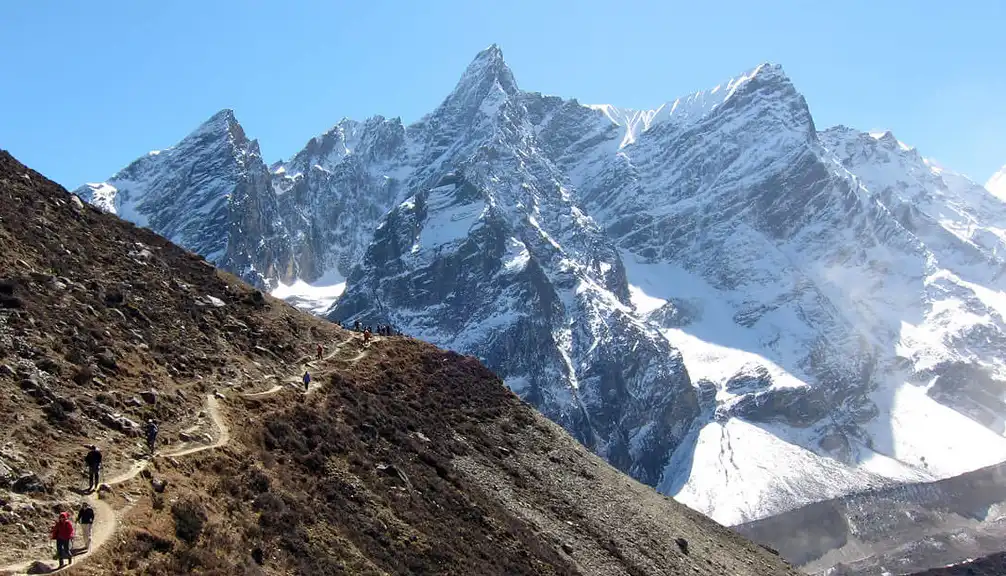
As you climb to Manaslu Province, you will pass through a variety of terrain, from vibrant subtropical forests to pristine alpine terrain. The Manaslu Walk gives you a taste of aboriginal culture as you walk through ancient villages, showcasing local traditions and daily life. The Manaslu Circuit Walk, which rises to over 5,000 meters, requires careful planning and flexibility to ensure your experience is fun and safe.
Manaslu Circuit Trek Highlights
- Larkya La Pass: Reach the trek’s highest point at 5,106 meters and soak in the expansive mountain vistas.
- Tsum Valley: Explore serene landscapes dotted with ancient monasteries and steeped in rich Tibetan traditions.
- Manaslu Base Camp: Get up close to the imposing Mount Manaslu for an unforgettable view.
- Sama Gaon: Immerse yourself in the local culture in this village, which is rich with Tibetan influences.
- Birendra Lake: Reflect beside this peaceful glacial lake, nestled in the mountains.
- Nepalese and Tibetan Culture: Engage directly with the customs and daily activities of the Gurungs and Tibetans.
- Flora and Fauna: Discover a variety of wildlife, including the elusive Himalayan Tahr and the sturdy Blue Sheep.
Preparation is key, and a dependable Manaslu circuit trek map is indispensable for route finding. Opting for the Manaslu base camp trek can enrich your experience, bringing you closer to the formidable peak and offering insights into the challenges climbers face. Crafting a thorough Manaslu trek itinerary is vital for maximizing the trek’s potential, enabling you to experience every aspect of this extraordinary adventure fully.
Manaslu Circuit Trek
Tsum Valley Trek
Annapurna Circuit Trek
Manaslu Trekking Route
The Manaslu trekking route guides you through one of Nepal’s most pristine and stunning landscapes. Known as the Manaslu Circuit Trek Route, this path winds around Mount Manaslu, the world’s eighth-highest mountain, showcasing a vibrant mix of cultures and breathtaking natural beauty. Trekkers refer to this path as the Manaslu route, celebrated for its remote beauty and the challenges it presents to visitors from across the globe.
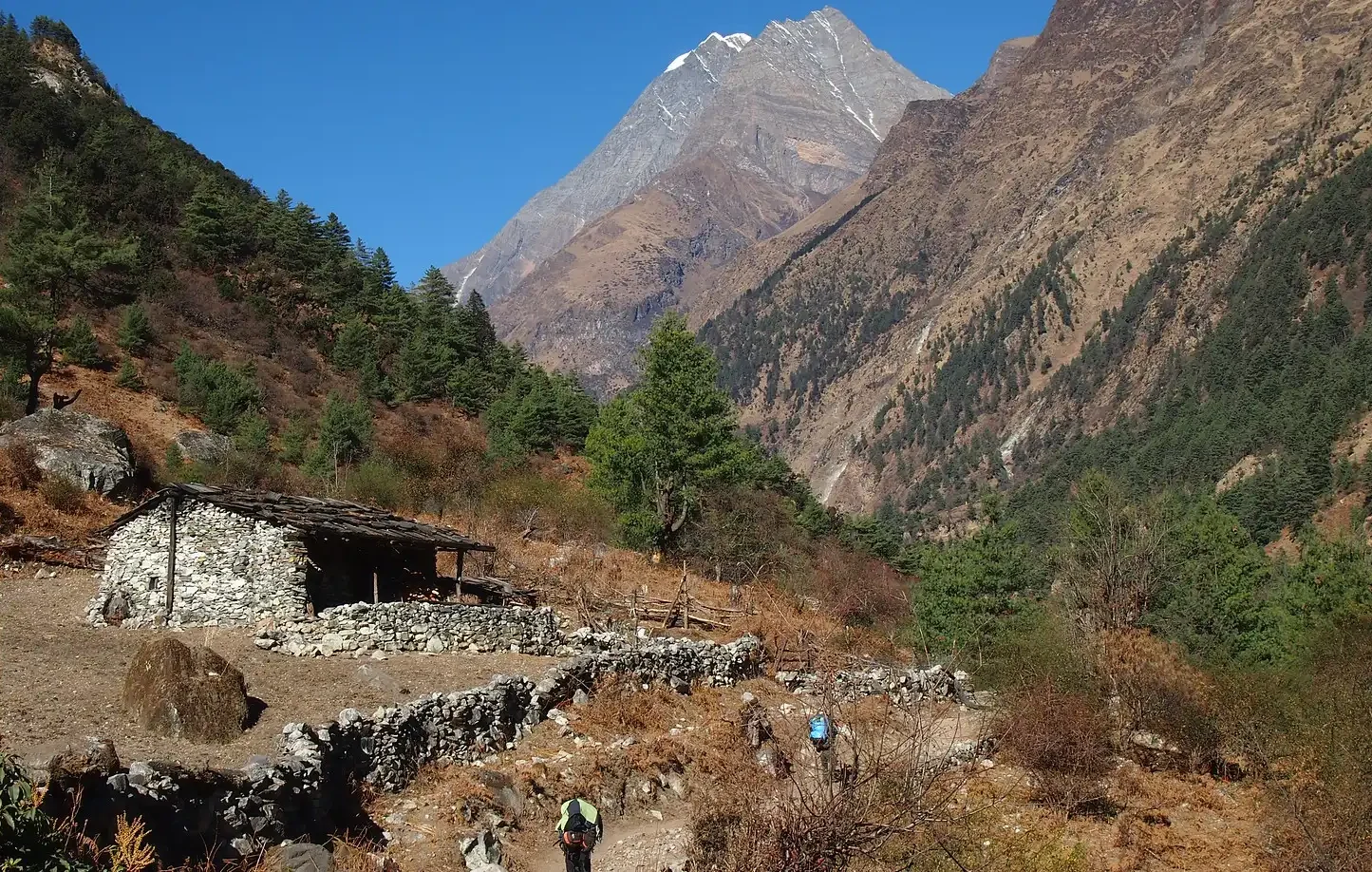
The adventure begins in either Arughat or Soti Khola, reachable after a drive from Kathmandu. From there, the Manaslu trekking route climbs through lush forests and passes traditional Gurung villages. You’ll frequently cross the Budhi Gandaki River on swinging suspension bridges, experiencing a variety of ecosystems and landscapes. Upon entering the Nupri region, the trail becomes steeper and features Tibetan influences, with spiritual chortens and mani walls enhancing the trek’s mystical feel.
Ascending further, the Manaslu Circuit Trek Route takes you up to the Larkya La Pass, sitting at an elevation of 5,106 meters. This part of the Manaslu route is especially remarkable, offering wide-ranging views of towering peaks like Himlung Himal, Cheo Himal, and Kang Guru. Descending from Larkya La, you move through alpine meadows and pine forests within the Annapurna Conservation Area, a stark contrast to the barren landscapes above.
The Manaslu trekking route wraps up as you make your way through the Marsyangdi valley, moving past Bhimtang and Dharapani to join the well-trodden Annapurna Circuit route. This trek not only challenges you physically but also immerses you in the cultural nuances of Nepal’s mountain communities.
Manaslu Circuit Trek Itinerary
The Manaslu Circuit trek itinerary meticulously outlines your trip through remote and breathtaking landscapes. Your trek begins with your arrival in Kathmandu, featuring a day of exploring the rich cultural landmarks of the valley.
The trip to Soti Khola marks the official start of your trek. As you climb through lush forests and quaint villages, you’ll ascend to greater heights, preparing for acclimatization crucial for the trek’s higher altitudes. Following the Manaslu Circuit Trek Route, you navigate through picturesque terrains, crossing the Budhi Gandaki River numerous times.
You face the challenge of ascending Larkya La Pass, which towers at 5,106 meters and rewards you with stunning vistas. After descending through alpine meadows, the trail eventually joins the Annapurna Circuit route at Dharapani, culminating in a scenic drive back to Kathmandu.
Day 1: Arrival in Kathmandu (1,400m)
Day 2: Kathmandu Valley Sightseeing
Day 3: Drive from Kathmandu to Soti Khola (710m) – 8-9 hours
Day 4: Trek from Soti Khola to Machha Khola (900m) – 6-7 hours
Day 5: Trek from Machha Khola to Jagat (1,410m) – 6-7 hours
Day 6: Trek from Jagat to Deng (1,804m) – 6-7 hours
Day 7: Trek from Deng to Namrung (2,630m) – 6-7 hours
Day 8: Trek from Namrung to Samagaun (3,530m) – 6-7 hours
Day 9: Acclimatization Day in Samagaun
Day 10: Trek from Samagaun to Samdo (3,875m) – 4-5 hours
Day 11: Trek from Samdo to Dharmasala (4,460m) – 4-5 hours
Day 12: Trek from Dharmasala to Bhimtang (3,720m) via Larkya La Pass (5,106m) – 8-9 hours
Day 13: Trek from Bhimtang to Tilije (2,300m) – 5-6 hours
Day 14: Trek from Tilije to Bagarchap (2,160m) and drive to Besisahar – 5-6 hours trek, 4 hours drive
Day 15: Drive from Besisahar to Kathmandu – 5-6 hours
Day 16: Departure
Everest Base Camp Trek
Everest Base Camp Trek with Helicopter Return
Luxury Everest Base Camp Trek
Manaslu Circuit Trek Map
The Manaslu Circuit Trek map serves as an essential guide for navigating this picturesque trek. It outlines the trip starting from Soti Khola, passing through key villages like Machha Khola, Jagat, Deng, and Namrung, ascending to the Larkya La Pass, and descending to Bhimtang and Dharapani. This map provides crucial altitudes, distances, and landmarks, helping trekkers prepare for varying terrains and elevation changes.
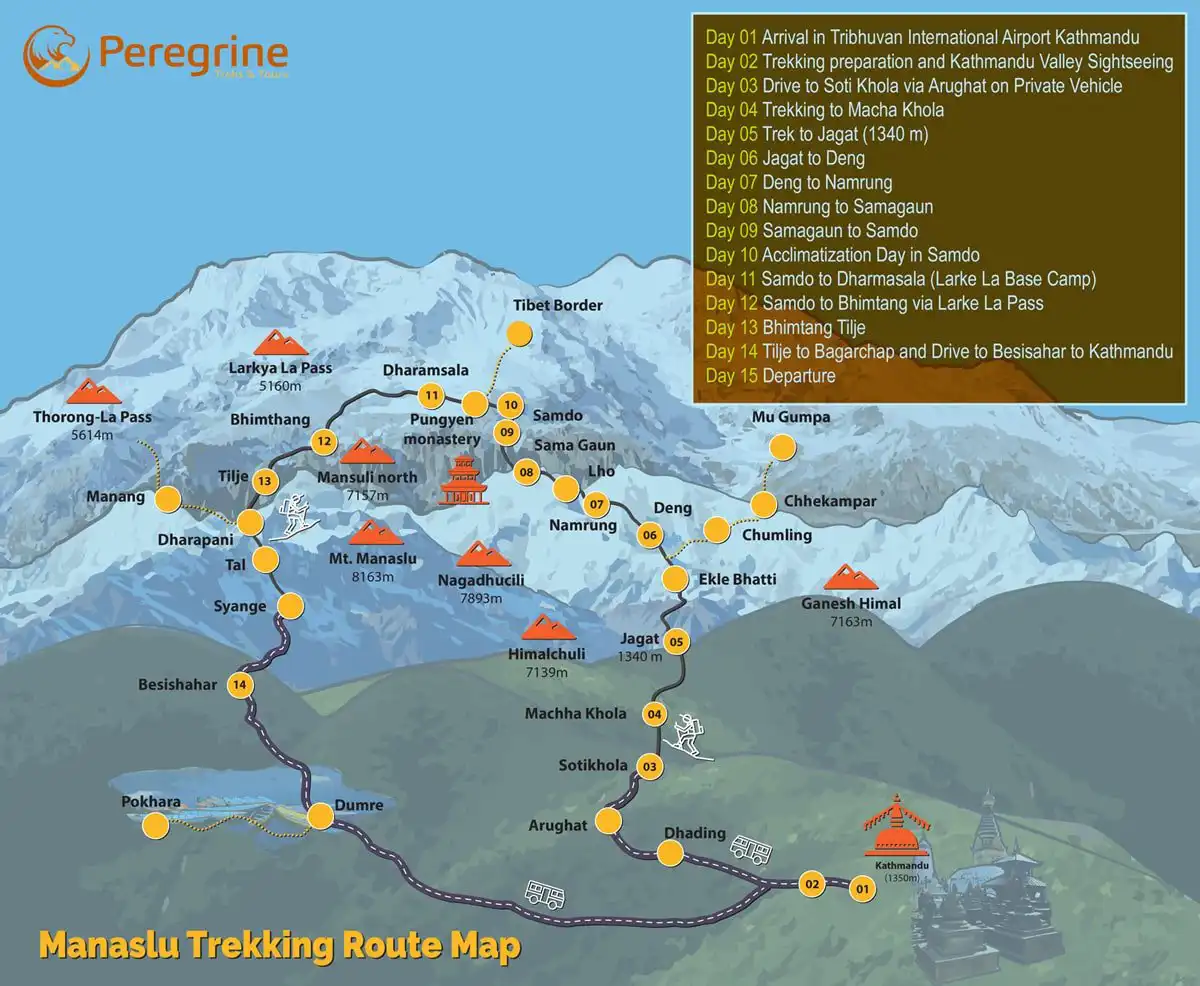
Trekkers can use the Manaslu Circuit Trek map to plan their route efficiently, identify safe rest stops, and manage acclimatization points. The map features significant cultural and natural sites, such as Tibetan-influenced villages and panoramic mountain views, enhancing the trekking experience with clear visual guidance. This tool aids both logistical planning and immersive exploration of the Manaslu region.
Manaslu Circuit Trek Difficulty
The Manaslu Circuit Trek is challenging due to its high altitudes and rugged terrain. Below is a detailed explanation of the various aspects contributing to its difficulty:
Altitude
Trekkers reach a maximum elevation of 5,106 meters at Larkya La Pass, which increases the risk of altitude sickness. Monitoring symptoms like headaches, nausea, and dizziness is essential. Acclimatization days are crucial.
Terrain
The trek involves steep ascents, rocky paths, and narrow trails. Trekkers navigate suspension bridges, river crossings, and high mountain passes, requiring good physical fitness and stamina.
Weather Conditions
Weather in the Manaslu region is unpredictable, especially at higher altitudes. Trekkers must prepare for cold temperatures, high winds, and possible snowfall, particularly at Larkya La Pass. Proper clothing and gear are vital.
Duration and Distance
The trek covers about 177 kilometers over 14-18 days, with long trekking hours of up to 8-9 hours a day. It demands significant endurance and perseverance. Adequate preparation and training are necessary.
Acclimatization
Acclimatization is critical due to high elevations. The trek itinerary includes rest days to help trekkers adjust to the altitude. Skipping acclimatization can lead to severe altitude sickness and dangerous conditions.
Physical Fitness
A high level of physical fitness is required. Trekkers should prepare for continuous walking on uneven and steep terrains. Pre-trek training, including cardiovascular exercises, strength training, and hiking practice, is recommended.
Remoteness
The Manaslu region is remote, with limited access to medical facilities and amenities. Trekkers need to be self-sufficient, carry necessary supplies, and prepare for emergencies. Emergency evacuation can be challenging, so having a reliable guide and support team is crucial.
Manaslu Circuit Trek Altitude
The Manaslu Circuit Trek altitude begins at Soti Khola (710 meters) and ascends to its peak at Larkya La Pass (5,106 meters). This significant change in elevation presents trekkers with a range of climates and landscapes, making acclimatization essential.
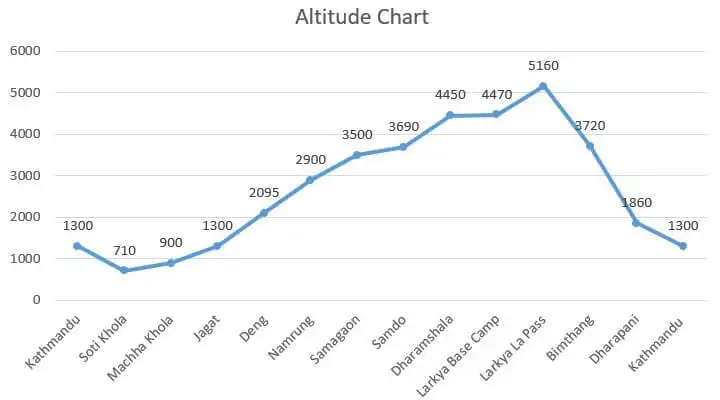
Along the way, trekkers pass through important locations such as Machha Khola (900 meters), Jagat (1,410 meters), and Namrung (2,630 meters), steadily increasing in altitude. Further along, they reach Samagaun (3,530 meters) and Samdo (3,875 meters) before confronting the high-altitude challenge of Larkya La Pass.
Managing the Manaslu Circuit Trek altitude is crucial to prevent altitude sickness. Ensuring proper acclimatization days is key to adapting to lower oxygen levels at higher elevations, making the trek both safe and enjoyable.
Manaslu Trek Permits and Costs
Trekking in the Manaslu region, a restricted area requires three permits from the Department of Immigration obtained through a registered trekking agency. Solo trekking is not allowed; you need at least two trekkers and a licensed guide. Here are the details:
Manaslu Permit Fees
- Autumn Season (Sept – Nov): $100 per week, plus $15 per day beyond a week.
- Winter, Spring, Rainy Seasons (Dec – Aug): $75 per week, plus $10 per day beyond a week.
Conservation Area Permit Fees
- MCAP (Manaslu Conservation Area Project): 3000 NRS.
- ACAP (Annapurna Conservation Area Project): 3000 NRS.
Tsum Valley Permit Fees
- Autumn Season (Sept – Nov): $40 per week, plus $10 per day beyond a week.
- Winter, Spring, and Summer Seasons (Dec – Aug): $30 per week, plus $7 per day beyond a week.
Accommodation and food during the Manaslu Circuit Trek
During the Manaslu Circuit Trek, accommodation primarily involves staying in teahouses. These guesthouses provide basic amenities such as a bed, blanket, and often a shared bathroom. They are available in most villages along the route, including Machha Khola, Jagat, and Samagaun. At higher altitudes, teahouses may be more basic, yet they offer a warm shelter and a resting place after a day’s trek.
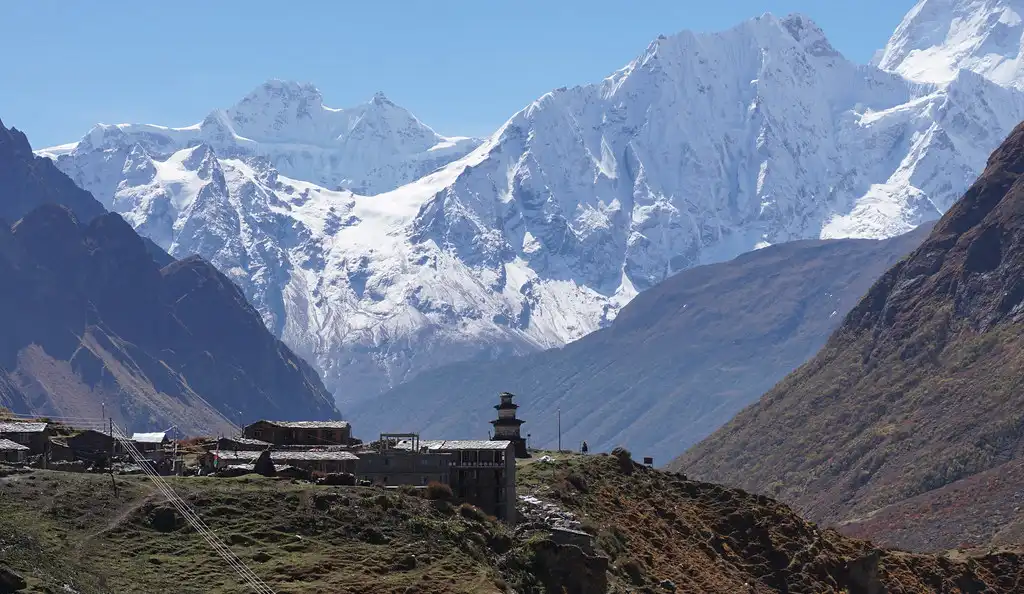
These teahouses also provide food on the Manaslu Circuit Trek. Typical meals include dal bhat (lentil soup with rice), noodles, soups, and occasionally Western dishes like pancakes and pasta. While meals are simple, they are nourishing and designed to fuel trekkers for their trek. Fresh vegetables can be scarce at higher altitudes, but the food remains hearty and warm, ensuring trekkers stay energized throughout the trek.
Best Time to Trek Manaslu Circuit
Autumn (September to November)
Autumn is considered the best time for the Manaslu Circuit Trek due to its stable weather conditions and clear skies. Trekkers can enjoy mild daytime temperatures, making the trek comfortable, while cooler nights remain manageable. The consistent weather ensures stunning panoramic views of the mountains.
Post-monsoon, the landscapes are lush and vibrant, enhancing the trekking experience. Autumn coincides with several local festivals, offering a unique cultural experience. Villages along the route come alive with traditional celebrations and welcoming atmospheres.
However, during the peak season, trails and teahouses can be busier. Booking accommodations in advance and preparing for crowded trails help ensure a smoother trekking experience.
Spring (March to May)
Spring is another ideal season for the Manaslu Circuit Trek. Mild temperatures and stable weather make trekking enjoyable. One of the highlights is the blooming rhododendrons and other wildflowers, adding vibrant colors to the landscape. Clear skies and pleasant temperatures provide excellent views of the mountains and the natural beauty of the region.
Longer daylight hours in spring allow trekkers to take their time and fully appreciate their surroundings. While less crowded than autumn, there are still plenty of fellow trekkers to meet and share the experience with. The combination of favorable weather, beautiful scenery, and a moderate number of trekkers makes spring a fantastic time for the Manaslu Circuit Trek.
Winter (December to February)
Winter offers a challenging but rewarding experience for the Manaslu Circuit Trek. Cold temperatures and heavy snowfall make the trek more difficult, particularly at higher altitudes. However, for experienced trekkers prepared for harsh conditions, winter provides a unique and tranquil trekking experience.
The trails are much quieter, offering solitude and peace that are hard to find during busier seasons. The snow-covered landscapes in winter are stunning, and the crisp, clear air offers exceptional visibility of the mountain peaks.
Trekkers must be well-prepared with appropriate gear and clothing to handle the cold and potential snow. Regularly checking weather conditions and careful planning ensure a safe and serene winter trekking experience.
Monsoon (June to August)
The monsoon season is the least favorable time for the Manaslu Circuit Trek due to heavy rainfall and associated risks. Slippery and muddy trails increase the risk of falls and injuries, while landslides are more common, posing significant dangers.
Additionally, sponges are prevalent in lower-altitude areas, which can be unpleasant for trekkers. Despite the challenges, the monsoon season transforms the landscape into a lush, green paradise, with waterfalls and rivers at their fullest.
Trekkers who choose to brave the monsoon should prepare with waterproof gear and a willingness to adapt to the weather. While challenging, trekking during the monsoon can provide a different and refreshing perspective on the Manaslu region.
Trekking Manaslu Circuit – Preparation and Packing List
Essential Gear and Equipment
To prepare for the Manaslu Circuit Trek, you need essential gear to tackle the diverse terrain and weather conditions:
- Trekking Boots: Choose waterproof, sturdy boots with good ankle support for rough terrain.
- Backpack: Opt for a comfortable, durable backpack with a capacity of 50-65 liters.
- Sleeping Bag: Bring a high-quality sleeping bag rated for sub-zero temperatures, as nights can be very cold.
- Trekking Poles: Use trekking poles to maintain balance on steep, rocky, or slippery sections.
- Water Purification: Carry water purification tablets or a filter to ensure access to safe drinking water.
Recommended Packing List
When packing for the Manaslu Circuit Trek, ensure you cover all necessities, from clothing to emergency supplies. Here’s a recommended list:
- Clothing: Pack layered clothing, including moisture-wicking base layers, insulating layers, and a waterproof outer layer. Remember, thermal hats, gloves, and socks.
- Navigation Tools: Even with a guide, bring maps, a compass, or a GPS device for safety.
- First Aid Kit: Include items for common ailments such as headaches, diarrhea, minor cuts, and altitude sickness medication.
- Sun Protection: Use high SPF sunscreen, sunglasses, and a wide-brimmed hat to protect against strong UV rays at high altitudes.
- Snacks and Nutrition: Pack high-energy bars and snacks to keep you fueled during long trekking days.
Why Choose the Manaslu Circuit Trek?
The Manaslu Circuit Trek offers a quieter alternative to the well-trodden Annapurna and Everest Base Camp treks. Unlike these popular routes, Manaslu remains less crowded due to its restricted area status, which requires special permits and limits the number of trekkers.
This trek combines the scenic beauty and cultural depth of the Annapurna region with the rugged, remote feel of the Everest trails, providing a unique and authentic experience. The Manaslu Circuit Trek leads trekkers through diverse landscapes, ranging from lush subtropical forests to alpine meadows and high mountain passes. You will enjoy stunning views of Mount Manaslu, the world’s eighth-highest peak, and the challenge of crossing the Larkya La Pass.
Along the way, you’ll encounter traditional Tibetan-influenced villages, ancient monasteries, and vibrant festivals, offering a deep cultural immersion. This trek’s blend of natural beauty and cultural heritage makes it a memorable adventure, distinct from more commercialized trekking routes.
Manaslu Circuit Trek Distance
The width of the Manaslu Circuit walk is about 177 km (110 miles). The trail takes you through a variety of terrains, including dense forests, high mountain meadows, and steep mountain trails. The trek usually starts from Soti Khola and ends at Dharapani, with an average walking distance of 15 to 20 km per day. The exact route may vary depending on the route and any side trips, such as a visit to Tsum Valley.
Covering this distance requires a high level of physical fitness and endurance due to the multiple ascents and descents across challenging terrains. The trek’s most strenuous section is the Larkya La Pass, the highest point at 5,106 meters. Despite the difficulty, the trek offers breathtaking and varied scenery, making the effort worthwhile and providing a rewarding experience for trekkers.
Transportation in Manaslu Circuit Trek
The Manaslu Circuit Trek begins with an 8-9 hour drive from Kathmandu to Soti Khola, the trek’s starting point. This drive covers rough and scenic terrain, giving you an early taste of the adventure to come. Depending on the season and road conditions, the trek can be challenging but rewarding, as it offers glimpses of Nepal’s diverse landscapes.
At the trek’s end, you drive from Dharapani to Besisahar and then transfer back to Kathmandu. This return trip allows you to relax and reflect on your trekking experience while enjoying the beautiful scenery.
Frequently Asked Questions
1. How many days for the Manaslu Circuit Trek?
The Manaslu Circuit Trek usually takes 14 to 18 days to complete. This timeframe includes trekking from Soti Khola to Dharapani, allowing time for acclimatization and rest. If you plan to add side trips like the Tsum Valley, the trek can extend to around 21 days, giving you a richer experience of the region.
2. Can you do the Manaslu Trek in 7 days?
Completing the Manaslu Circuit Trek in 7 days is not feasible due to the extensive distance and the necessity for proper acclimatization.
The trek spans approximately 177 kilometers, with daily trekking distances averaging 15-20 kilometers. Attempting to rush this trek could lead to severe altitude sickness and increase the risk of injuries due to fatigue.
3. How difficult is the Manaslu Circuit?
The Manaslu Circuit Trek is considered challenging due to its varied terrain, high altitudes, and long daily trekking hours. Trekkers need to be in good physical condition and mentally prepared.
The trek’s highest point, Larkya La Pass, at 5,106 meters, requires careful acclimatization to avoid altitude sickness. Proper preparation, including cardiovascular training and strength exercises, significantly improves the chances of completing the trek comfortably.
4. Do you need a guide for the Manaslu Circuit Trek?
Yes, you are required to have a licensed guide for the Manaslu Circuit Trek. The Manaslu region is a restricted area, and solo trekking is not permitted. A guide helps with navigation, ensures safety, assists in obtaining necessary permits, and provides valuable insights into the local culture and environment.
5. Is Manaslu harder than Everest?
People often compare the Manaslu Circuit Trek and the Everest Base Camp Trek in terms of difficulty. Both treks involve high altitudes and challenging terrain. However, Manaslu is less commercialized, making it feel more remote and rugged. Some trekkers find Manaslu more challenging due to its isolation and less developed infrastructure.
6. Is Manaslu harder than Annapurna?
The Manaslu Circuit Trek is generally considered more challenging than the Annapurna Circuit. Manaslu’s higher altitudes, less developed infrastructure, and more remote location contribute to its difficulty. In contrast, the Annapurna Circuit has more established facilities and a broader network of teahouses, making it somewhat easier for trekkers.
7. How many people died in Manaslu?
While specific statistics on fatalities during the Manaslu Circuit Trek are not readily available, the trek can be dangerous due to high altitudes and challenging conditions. Trekkers must be well-prepared and follow safety guidelines to minimize risks. For accurate and recent information, consult local trekking agencies or guides.
8. Do you need oxygen to climb Manaslu?
Supplemental oxygen is typically not required for the Manaslu Circuit Trek, but it is essential for climbing Mount Manaslu itself, which is a separate expedition requiring advanced mountaineering skills. Trekkers should be aware of altitude sickness symptoms and take necessary precautions.
9. Is Manaslu hard to climb?
Climbing Mount Manaslu is a challenging expedition requiring advanced mountaineering skills, proper acclimatization, and often supplemental oxygen. The Manaslu Circuit Trek itself is demanding but does not require technical climbing skills.
10. What is the success rate of Manaslu?
The success rate for summiting Mount Manaslu varies but is generally considered achievable compared to other 8,000-meter peaks. For the Manaslu Circuit Trek, most trekkers who are well-prepared and acclimatized complete the route. Following a proper itinerary and allowing enough time for acclimatization are essential for a successful trek.
11. What is the highest point of the Manaslu Circuit Trek?
The highest point of the Manaslu Circuit Trek is the Larkya La Pass, which stands at an altitude of 5,106 meters (16,752 feet). This pass offers breathtaking views and is one of the most challenging parts of the trek.
Conclusion
The Manaslu Circuit Trek offers adventurers a unique blend of natural beauty and cultural richness. You will trek through diverse landscapes, from lush forests to high-altitude passes, and witness stunning views of Mount Manaslu, the world’s eighth-highest peak. The trek’s remoteness provides a more authentic and secluded experience compared to more commercialized routes like Everest or Annapurna Circuits.
By planning and undertaking the Manaslu Circuit Trek, you will gain unforgettable experiences, including interactions with traditional Tibetan-influenced villages, visits to ancient monasteries, and participation in vibrant local festivals. This challenging yet rewarding trek demands preparation and determination, but the breathtaking scenery and unique cultural encounters make it an adventure well worth pursuing.

